The post Sailing the Greek Islands (Yoga, Hiking and Wine Included) appeared first on The Expeditioner Travel Site.
]]>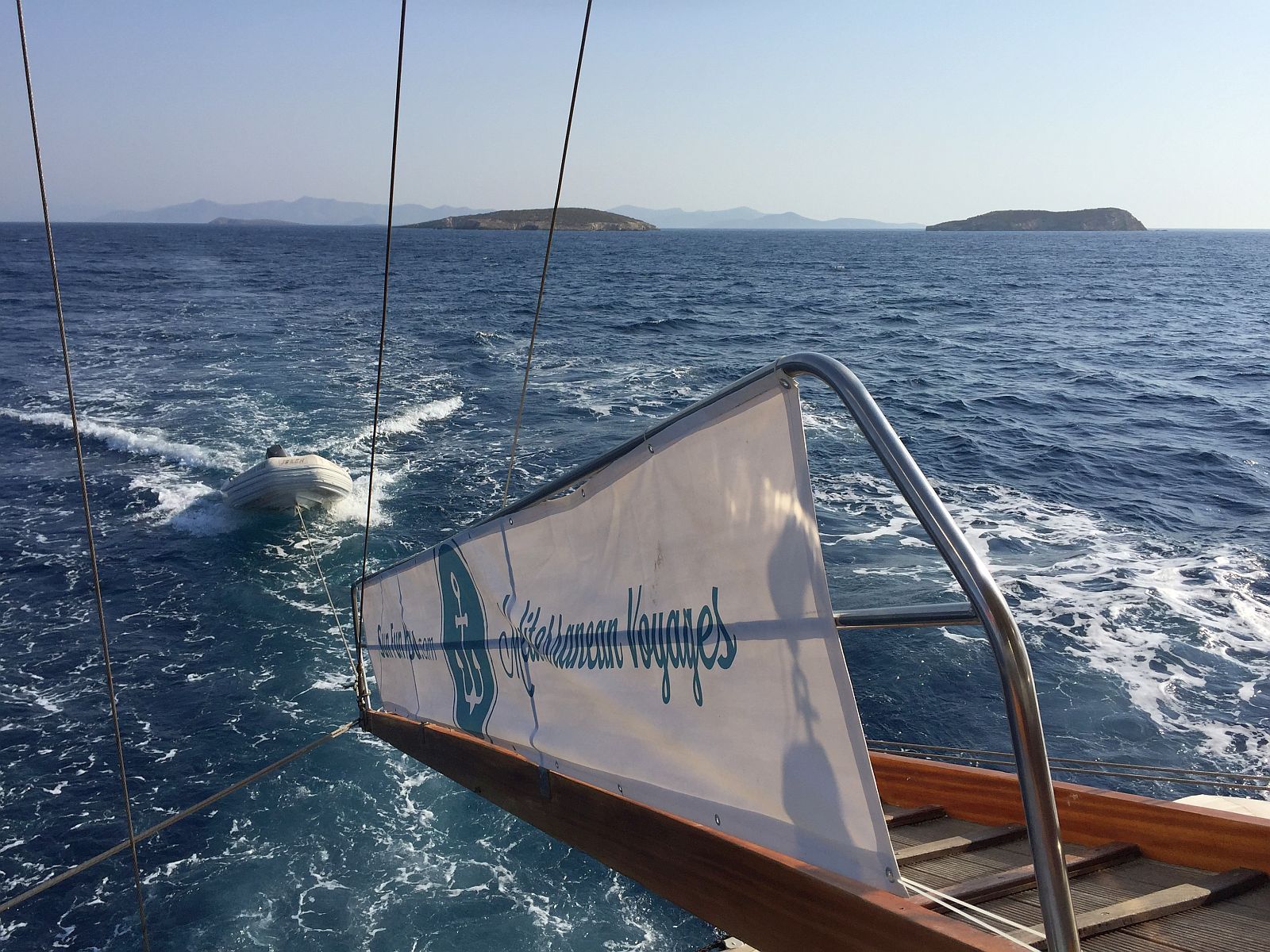
As our boat sailed out of the ancient Greek island harbor of Kos, our group of 10, mostly strangers, sat in a circle around a long, wooden table, studying a map spread out before us depicting the Dodecanese, the group of islands clustered together in the southeastern Aegean Sea. Our tour guide for the trip, Ali, was pointing out the various islands we were to visit over the next week.
“Today will be the longest sail,” he explained in a slow cadence, something we would get used to hearing after breakfast every morning as he announced the forthcoming day’s itinerary. “We are heading north to Patmos. From there we will turn around and visit many islands along the way until we come back to Kos. Of course, we will be doing many hikes and other physical activities along the way.”
My eyes wandered along the names of islands he was pointing to: Pserimos, Kampos, Patmos, Lipsi, Leros, Kalimnos. These were not the names of islands one sees on the cover of glossy brochures luring tourists to the Greek Islands or hears about over holiday dinners from distant relatives when discussing their summer trip.
No, this is officially off-the-beaten-path territory when it comes to the Greek Islands — at least for most tourists. For those who have spent time in the country, partying it up in Mykonos or wandering shoulder-to-shoulder with the crowds through the streets of Santorini, these are the islands one visits to see the other side of Greece. These are the islands where fisherman outnumber tourists on most days, where you’re more likely to run into a stray sheep than a stag party, and where traditions have continued uninterrupted for many millennia. This was the part of Greece I was most excited to see.
After finishing his introduction, Aislyn, our physical trainer for the week, introduced herself. After learning a bit about each of our fitness levels, she then announced that our first workout of the trip would be commencing shortly at the bow of the boat. “Don’t forget to bring your resistance bands that were in your welcome bag when you arrived!”
It goes without saying, this was not going to be your typical Greek island cruise.
It was the middle of September, and we had signed up with Sun Fun You for their active 7-day Greek Islands Voyage trip. The plan was to start from Kos, head north to Patmos, then island-hop south until we arrived back in Kos, sleeping in various coves, ports and docks along the way.
Not one for sitting around idly during my travels (especially on a boat), I was particularly interested in the fact that Sun Fun You places a large emphasis on physical activities. Not only would each day include a morning and afternoon fitness session, but there were also half-day hikes planned for each island we would be visiting. This means rarely a day would go by without some sort of workout to get the juices flowing (and to work off the large amount of feta one tends to consume here).
Our boat for the week, the Muhtesem, was technically a gulet, the term for the two-masted wooden boats typically found in this part of the world. Gulets are known for their ornamental, dark-wood exteriors and long, flat decks. Most are hand-built in nearby Turkey, just as ours was. I later learned our Captain personally oversaw the construction of the particular gulet we were on.
On deck there was a large, flat expanse at the bow where most of the workouts took place, and at the stern was large table used for group meals and which was surrounded by padded seating, perfect for afternoon naps. Below deck were eight cabins with adjoining private bathrooms and a cozy living room/den with a library stocked with Mediterranean-themed books and DVDs (I was inspired to pick up a copy of Zorba the Greek toward the end of the week).
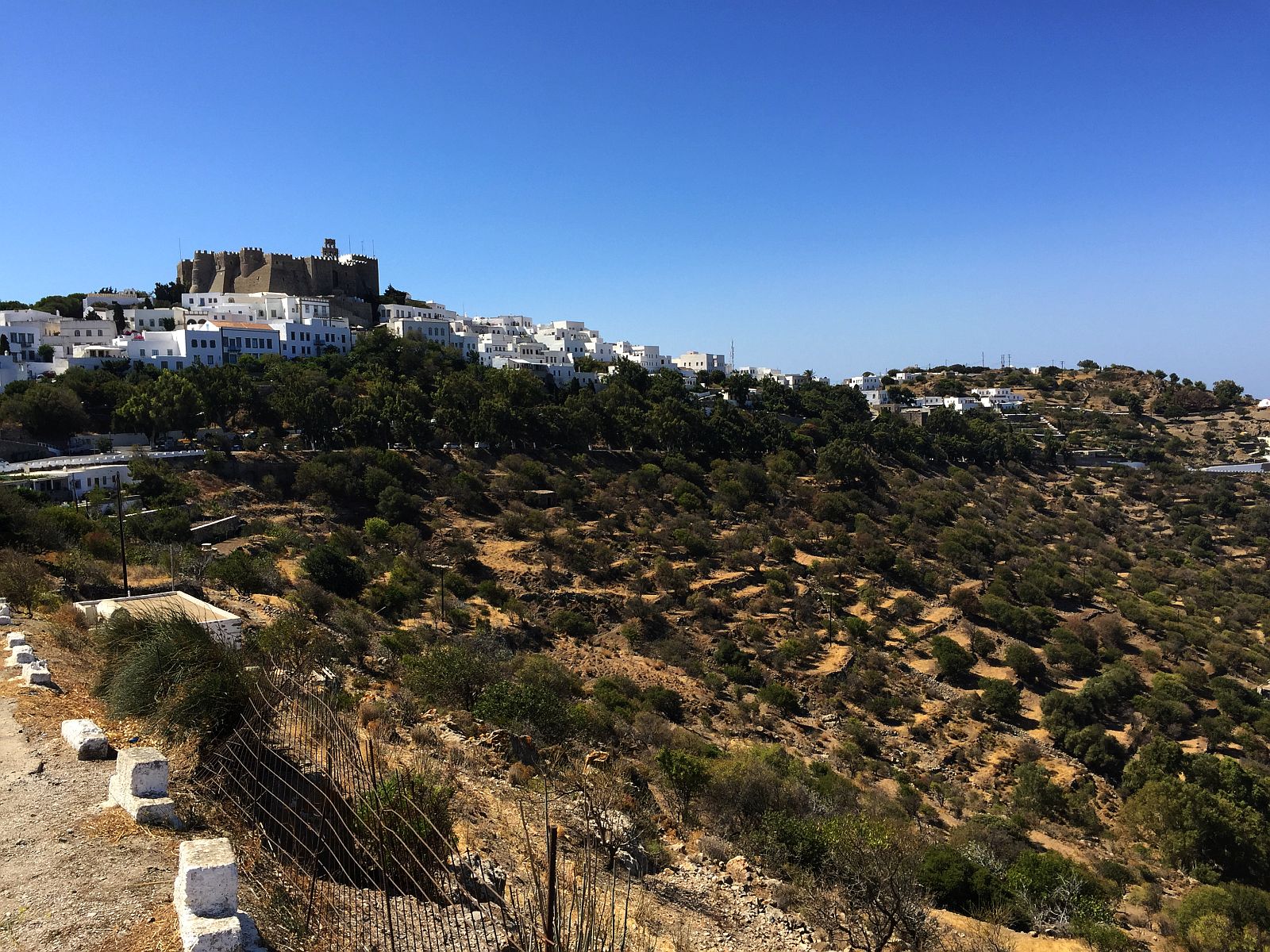
After our first humid night at sea, which resulted in half of the group taking their pillows and blanket outside to sleep, we arrived at our first stop, Patmos. Located on the northern tip of the Dodecanese, the island has a population of less than 3,000 and is well known in the Christian and Greek Orthodox religions as home to the Monastery of Saint John the Divine, the castle-like structure on a hilltop that is a pilgrimage site for many Christians.
After a short walk through the winding backroads of the town of Skala, Ali gathered our group at the base of the hill we would be ascending. “We are going to first visit the Cave of the Apocoloyps, the cave where it is believed John of Patmos — hidden away to avoid the detection of those hunting Christians throughout the region — wrote the Book of Revelation. Then we will head further uphill to the monastery. Please drink lots of water and don’t forget to put on your sunscreen!” Wise words as the early morning sun beat down, baking the parched land surrounding us. Ainslie then led us through a few stretches, and then we were off.
An hour later we arrived at the cave, a welcome respite from the heat due to its location in the side of the hill. After a visit to the austere chapel inside and a short break in the shade, we continued on, heading further uphill until the path ended at a set of large doors belonging to the monastery.
The monastery was initially built in 1088, and with its foreboding walls and numerous turrets, it appears to the naked eye more like a Byzantine castle than a church. Inside, an outdoor courtyard is surrounded by living space and a number of small chapels where the monks used to worship safely far from their prosecutors.
From the courtyard we took one last short walk up a steep staircase to the rooftop where we were treated to a panoramic view of the island below, our boat barely visible in the distance floating in the bay: a speck of brown in a shiny expanse of bright blue.
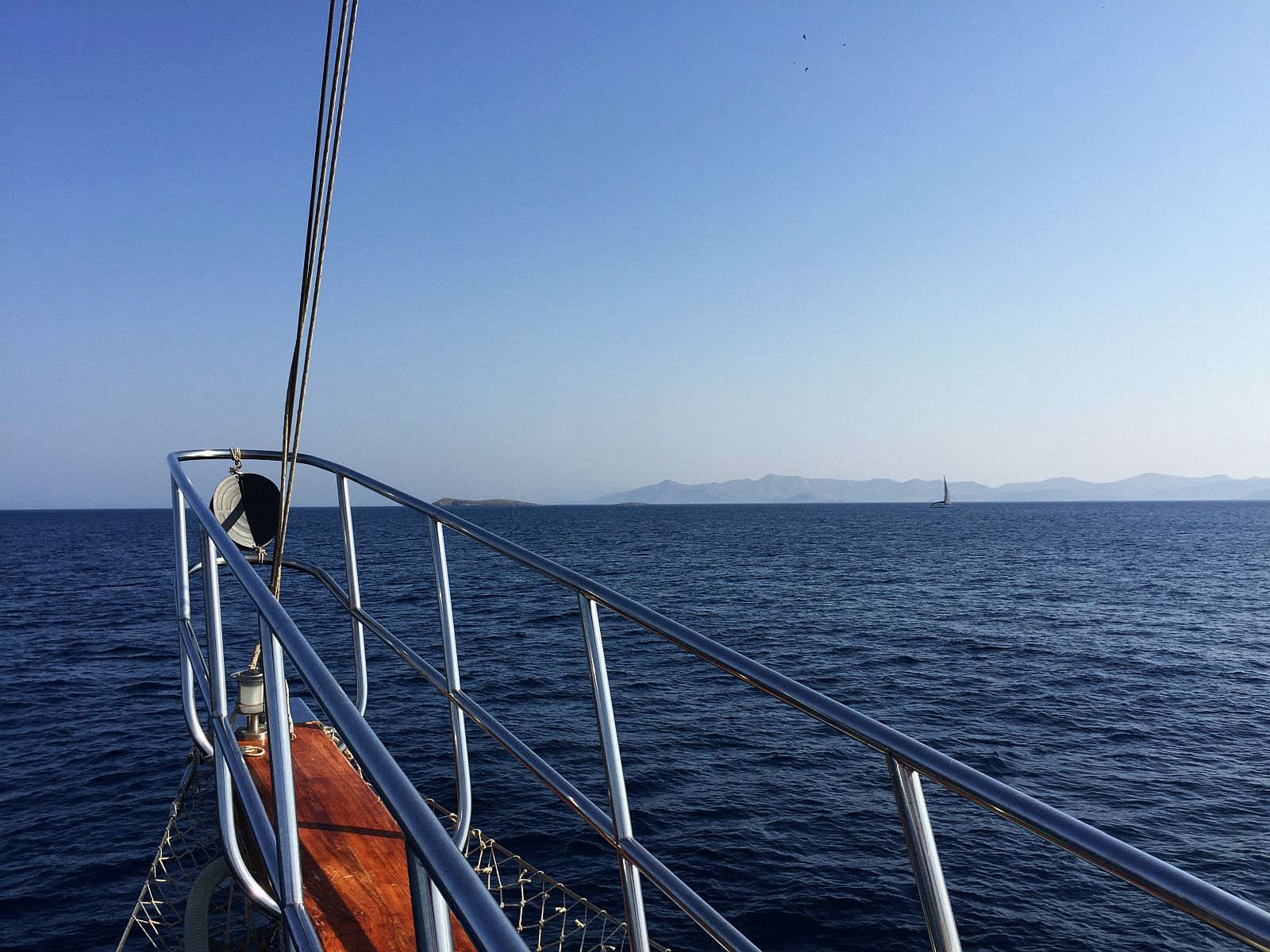
When out on the water, breakfast, lunch and dinner are all eaten family-style. The captain of the ship, with the help of a small crew, does double-duty as chef. Every meal was served with the obligatory Mediterranean accouterments including fresh bread, feta cheese, salad and a selection of olives, followed by our main meal and fresh fruit for dessert. Given the amount of calories each of us were burning each day, the sound of the bell being rung before every meal was usually followed by an ordered stampede of passengers eager to start digging in.
At night, after the table was cleared and drinks were topped off, we would break out a deck of cards, or more frequently, my recently purchased set of Cards Against Humanity, where we would play late into the night under a full set of stars and the sound of waves lapping against the boat’s hull.
One night, after most everyone had gone to sleep, I stayed up late with the boat’s crew drinking cans of Mythos and downing the occasional shot of raki, the anise-flavored liquor popular in this part of the Mediterranean. I asked the captain about the history of the Muhtesem. He explained that he actually owned the boat and helped to oversee its construction which was done using traditional techniques by boat-makers who can trace their trades back generations.
“After many years working as a chef in the kitchens of 5-star hotels, I finally quit my job to pursue my dream,” he explained, his eyes looking around at his prized possession. Later in the trip, I met his young daughter and wife who had come on board to visit, an infrequent event during the summers when he spends most of his time at sea at work in his new profession.
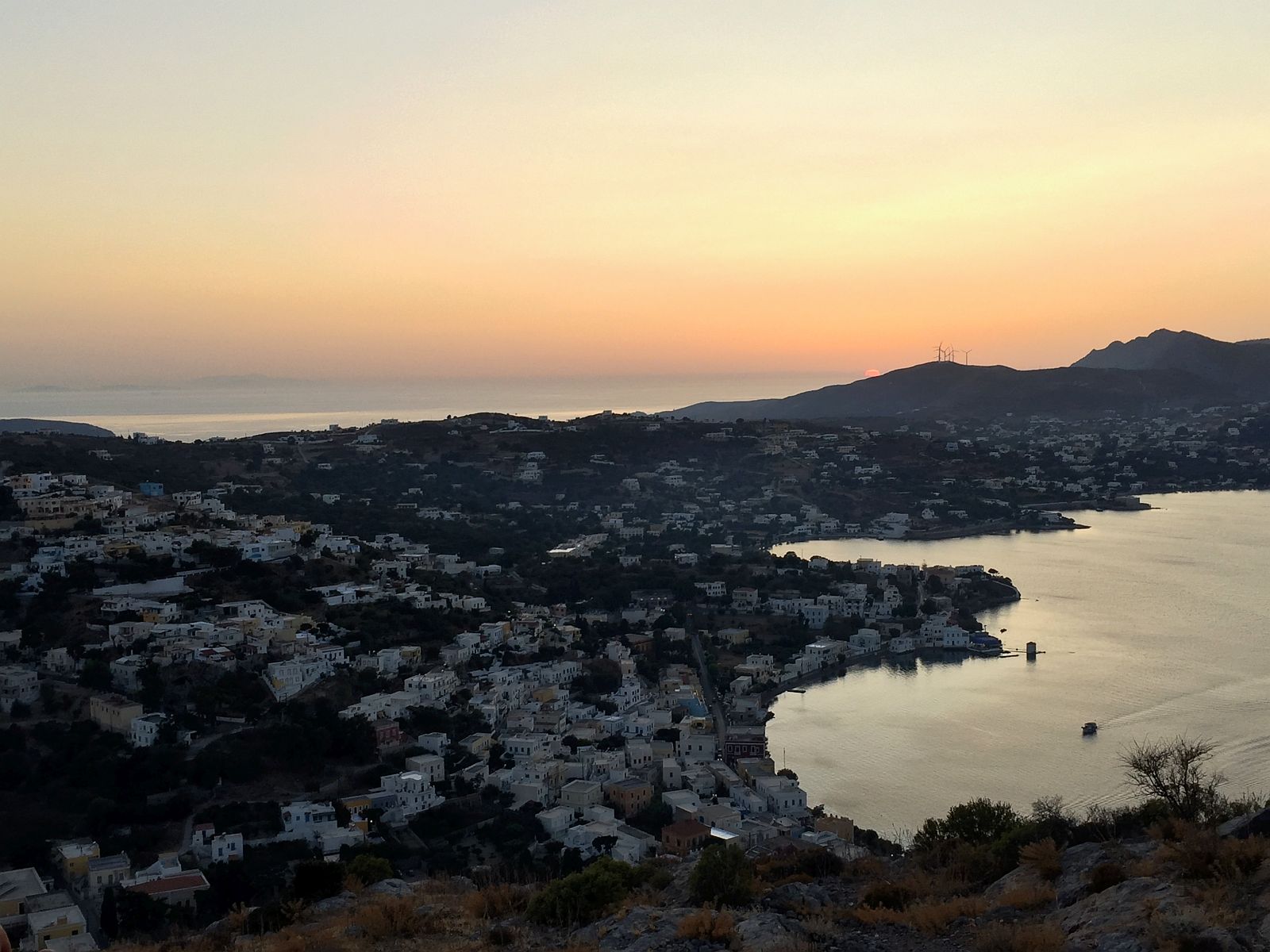
The next day we continued on to the island of Leros where we spent the morning at Aglia Maria Cove swimming, snorkeling along the shallow coastline and enjoying a short break before the sunset hike planned for later in the day. Temperatures for September in this part of Greece hover comfortably around 80 degrees Fahrenheit — a bit warm for sleeping in the cabins, but great for dozing under the stars and swimming. Looking back, I don’t think we saw a single cloud in the sky during the entire week we were there. Clearly, September is an ideal time to visit (we were also told July is a great time to come too; August not so much since it’s the hottest month of the year and uncomfortable during the day for doing much of anything, especially physical activities).
After we finished having fun in the water, we docked in Patneli, an old fishing village home to a small beach and marina, walked along the beach past the coastline cafes and bars, and set out through the windy streets toward the Castle of Pandeli, also known as the Castle of our Lady.
Built in the 10th Century, the castle was donated by the Byzantine Empire to the Monastery of Agios Ioannis Theologos, after which it was taken over by the Knights of Saint John and used to fend off invaders. Today, travelers can visit via an hour-long hike along a switchback road from the town center.
We arrived just in time, and with only minutes to spare before sunset. We quickly rushed around the castle to see the various fortifications that were built over the centuries — obligatory Game of Thrones references were of course made — and then we gathered for our first hilltop sunset in Greece. Known the world over for its sunsets — perhaps most notably for the crowds that gather nightly in Santorini — I can safely report our Leros sunset was just as good, and with the added benefit of having a few thousand fewer people around to share it with. As the sun made its final descent, the small group gathered here on the hilltop began to clap, cheering on the hazy orange and purple light peeking out from the horizon.
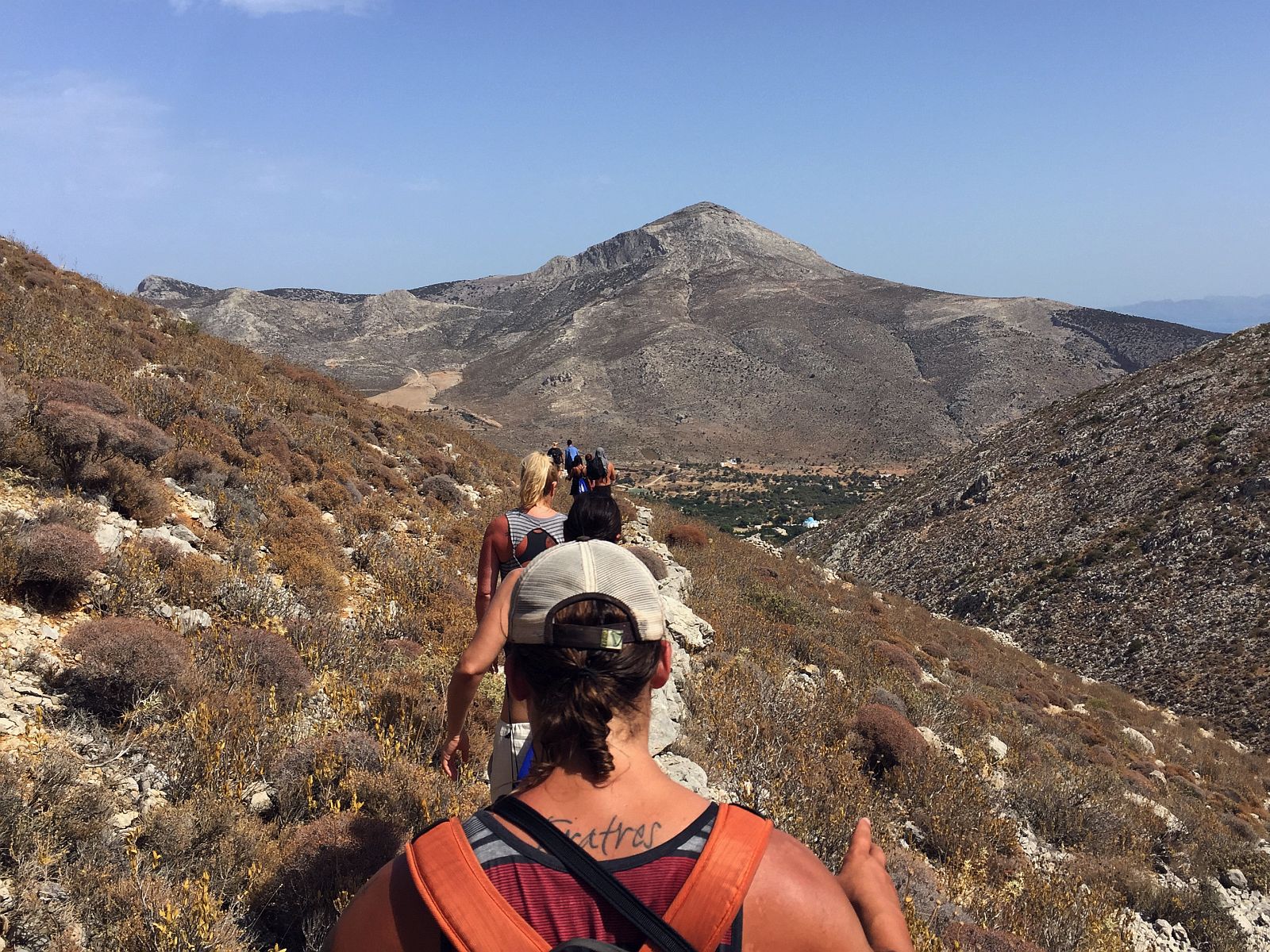
As soon as we pulled into port in Kalymnos, it was clear what the island is known for. All around town were signs heralding the arrival of the Kalymnos Climbing Festival in October, the logo depicting a climber hanging by one hand from the side of a cliff. With its many limestone cliff walls jutting out from the water, and with over 2,500 routes mapped out across the island, Kalymnos is known the world over as one of the best places in the world for sport climbing.
We were not here to climb, but instead to embark on the longest hike of the trip, the Italian Path, a 4-hour trek up and over a large ridge separating the town of Kalimnos from Vathis located on the opposite side of the peninsula. After breakfast, we set out along the marina, making our way past the many small charter boats and wooden crates full of natural sea sponges being peddled by hawkers, a commodity that has been collected and sold here for centuries.
The path’s name comes from the Italians who occupied the island from 1912 up until World War II, and who built the cobbled road to connect the two towns, otherwise inaccessible to each other except by boat. The path winds its way up a narrow hillside, then straightens out and plunges forward until you reach the crest of the ridge, with the southern half of the island splayed out below. With the sun beating down on us and the highest vegetation along the parched path reaching ankle-high, the group settled into a slow crawl forward. For fun (at least for me), I took out my phone and began streaming the theme to Lawrence of Arabia as we marched through the stifling heat.
After reaching the top, the path winds back down into a peaceful valley where olive orchards dot the landscape, then ends abruptly at the end of a long, dusty road. To get to the center of town, you have to continue on for at least another half-hour along a paved street.
Lucky for us, we were able to skip that leg of the hike. Exhausted and tired from our climb, our local guide for the day called a contact of hers, and a few minutes later a flatbed truck with a caged back, presumably for livestock, arrived driven by a large Greek man with a cigarette hanging from his lips. He herded us one-by-one into the back and drove us into town. When we pulled into the main square, the driver opened the back gate and I jumped out, feigning gratitude and kissing the ground, a confusing site for the dozens of tourists eating lunch there.
After our own lunch of grilled squid, a local specialty, we returned back to the boat, changed into our bathing suits, and spent the rest of the afternoon splashing about in the cool, refreshing bay’s water and watching the many climbers scale the cliffs above us, testing their skills in what may be some of the most picturesque climbs in the world.
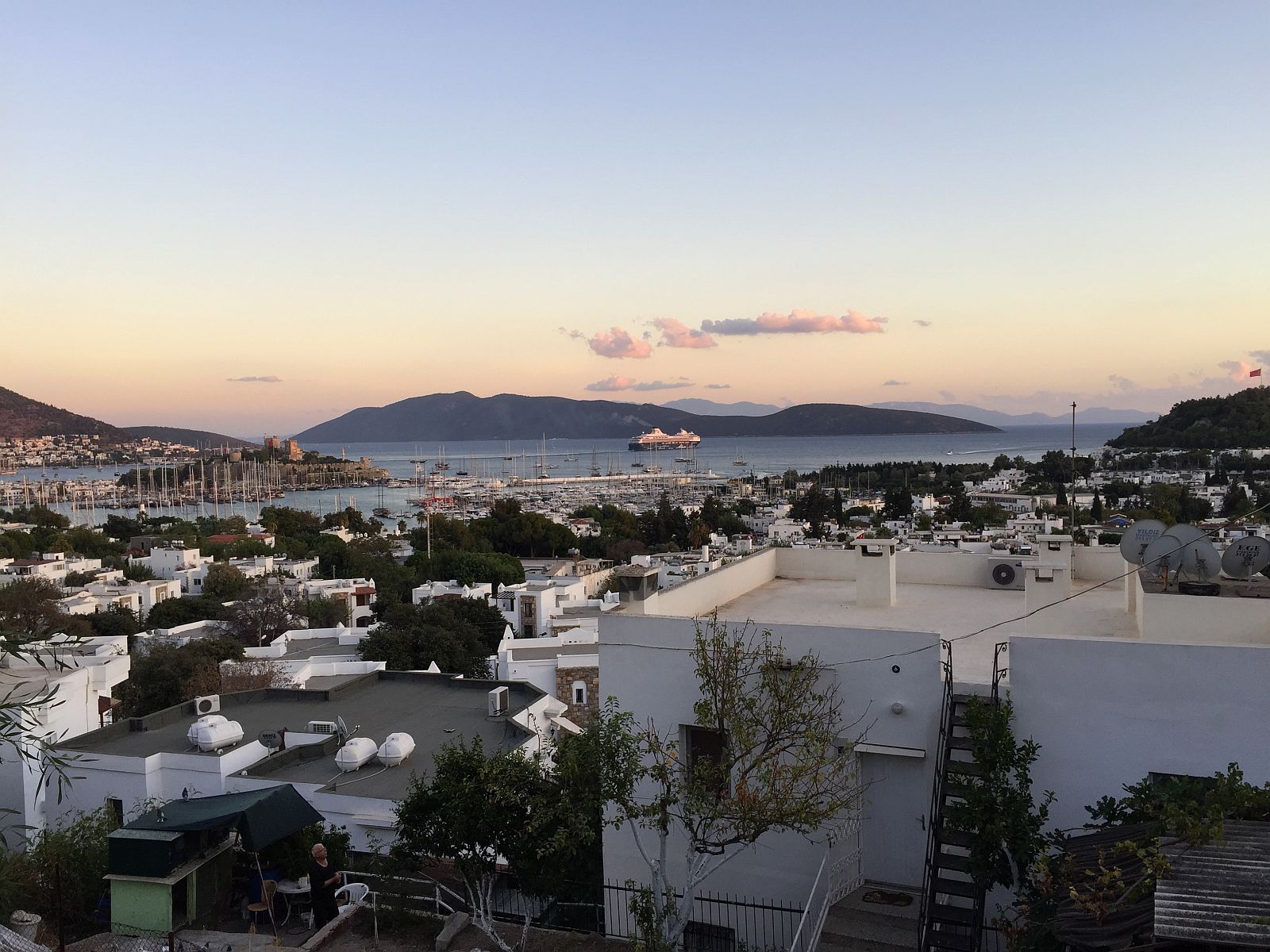
We woke up in the morning to the sound of the boat’s engines firing up. We had spent the muggy night outside on the top deck, falling asleep to the low din of the dockside clubs and to the sight of a night sky impossibly filled with clusters of stars.
Our next-to-last stop before arriving back at Kos was Bodrum, the port city on the Turkish coastline. Located on a peninsula jutting out in the Aegean sea, the town is a well-known vacation hot-spot for both the Turkish and European elite. It was also an Ancient Greek city with a fabled history (it was home to one of the Ancient Wonders of the World, the Mausoleum of Mausolus).
With an afternoon to spare, we decided to visit Bodrum Castle, the city’s most famous attraction. Built in 1402 by the Knights of St John, today the castle is home to the Museum of Underwater Archaeology, a collection of relics that have survived the centuries of invasion, earthquake, fires and human development that has frequented this part of the world since the dawn of civilization. On display in the castle’s many rooms you can find Egyptian jewelry, ancient Greek pottery and assorted coinage all coming from shipwrecks dating back to the 12th Century B.C.
Afterward, we took a stroll through the winding streets of the bazaar in the center of town, then sat at a second-story cafe, sipping apple tea while watching the many visitors in town walking through the marina.
In time for dinner, we met the group back on the boat for one of our last meals on deck. We had plans that evening to head out with everyone for hooka and to check out the many beachside bars. Sitting down around our wood table, Cynthia, the owner of Sun Fun You who had recently joined up with us, told stories with the boat’s crew as we drained the remaining bottle of wine on board.
She talked of the boat’s short history: how proposals had been made, babies conceived, and lifelong friendships created all in the short amount of time the boat had been plying these same waters where others have been voyaging for thousands of year. We lifted our glasses for a final group cheers, one last celebration here on our home away from home, out on the Mediterranean.

/
 Matt Stabile is based in New York City, and is the founder and Editor-in-Chief of The Expeditioner which was founded in 2008. You can read his writings, watch his travel videos or contact him via email at any time at TheExpeditioner.com.
Matt Stabile is based in New York City, and is the founder and Editor-in-Chief of The Expeditioner which was founded in 2008. You can read his writings, watch his travel videos or contact him via email at any time at TheExpeditioner.com.
The post Sailing the Greek Islands (Yoga, Hiking and Wine Included) appeared first on The Expeditioner Travel Site.
]]>The post Naked On The Loveliest Beach In The World appeared first on The Expeditioner Travel Site.
]]>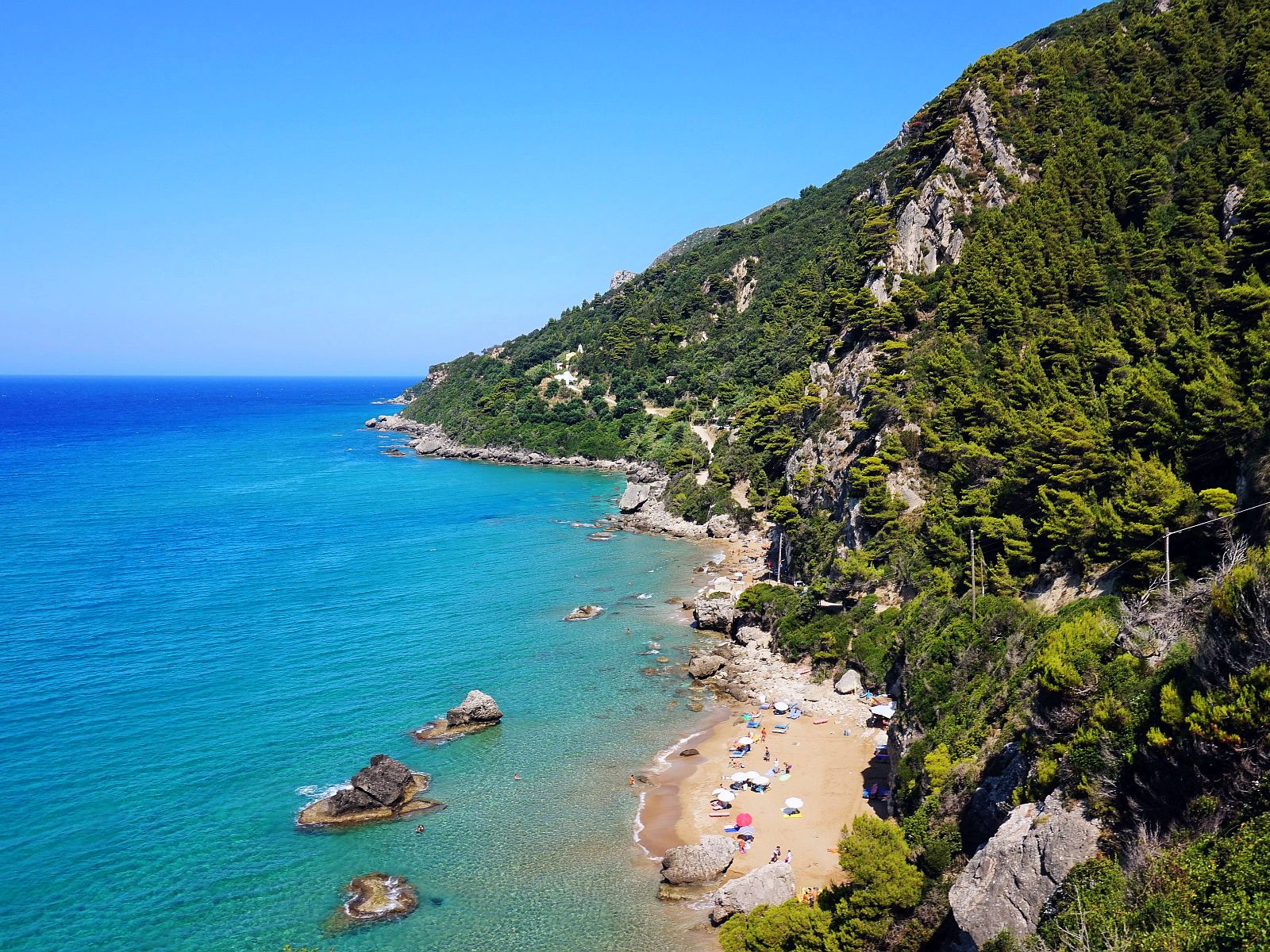
Steep, narrow and lacking guardrails, the crumbling cement road to Myrtiotissa Beach, Greece, appears to be headed over a cliff, and my husband, two young daughters and I along with it. Leaving the car parked slantwise along the shoulder, we continue on foot, the trill of cicadas rising and falling in the dusty summer heat. Around the bend in a hairpin turn, our destination bursts into view and we stop to take pictures.
A secluded crescent of golden sand, the beach nestles beneath the limestone cliffs on this otherwise rocky stretch of Corfu’s west coast. The Ionian Sea shimmers into the horizon in deepening shades of turquoise, umbrellas sprout from the sand, and we can just make out the tiny figures of people lounging in the sun and bobbing in the waves. From this distance, however, we cannot yet see what is missing: bathing suits.
Named after a small 14th-century monastery — Our Lady of the Myrtles, which is perched above it in the forested hills to the north — Myrtiotissa is the only officially tolerated nude beach on the island of Corfu. But we are not nudists, and we have come for the famed beauty of this place rather than a full-body tan. Writer Lawrence Durrell declared Myrtiotissa “perhaps the loveliest beach in the world” in Prospero’s Cell, a memoir of his life in Corfu as an expat during the late 1930’s. More recent travel guides contain similarly glowing reviews, one calling Myrtiotissa Europe’s “most stunning beach.”
With these superlatives in mind, and not a second thought about the dress-code, we set off from our hotel in Corfu Town this morning, rental car loaded with all manner of beach paraphernalia, bathing suits included. Yet now that we are here, I begin to doubt whether this was such a good idea, hesitating for a moment before leading my family through the towels and lounge chairs where mostly middle-aged tourists sprawl naked and sun-burned. Others drift about knee-deep in the clear, shallow water, their private parts on full display.
“Should I smile and nod hello or avoid eye contact?” I wonder, suddenly realizing that I know nothing about the rules and etiquette of nudism, or naturism, as the practice is also euphemistically called.

There is no turning back now, so I opt for the safer, less conspicuous approach and make a break for an unoccupied shaded area at the base of the cliffs. My husband settles in against the rocks with a sigh of relief while the girls bound off into the sea. I soon scamper after them with my camera — as I am wont to do — and begin snapping pictures while they frolic in the crystalline water.
“No photos,” says a bronzed brunette who seems to have sprung like Aphrodite from the sea foam and into my personal space just as I’m getting started.
She gestures toward a ramshackle drink stand in a far corner of the beach. There, scrawled across a scrap of wood in faded paint are the words: “no Foto.” Several onlookers frown and shake their heads and it dawns on me that I have just broken one of the cardinal rules of nudism only minutes after arriving here. I want to explain that I was merely taking photos of my own children, but instead mumble an apology and retreat to our encampment, camera between my legs.
Once my embarrassment subsides, I decide to go for a swim. A corpulent 60-something wearing nothing but sunglasses and a visor looks up from her magazine and scowls as I make my way across the hot sand. While bathing suits don’t seem to be expressly prohibited, I’m sensing that to wear one is a major faux pas. For the first time in my life I’m self-conscious about showing too little skin in my string bikini.
“So why not give it a try?” asks a quiet but persuasive voice inside my head, and then I’m untying my bathing suit and tossing it onto the ground in an uncharacteristic fit of impulsivity.
The girls giggle and splash as I plunge into the water and my husband, still hiding in the shade, looks on with amused interest.
“You are the mommy mermaid!” my daughters announce with glee, piling onto my back in a flurry of elbows, knees and slippery skin.
As I enter their imaginary salt-sprayed world, all my preoccupations, as well as the strangeness of being naked in public, quickly fade away. Time stands still as we play together, diving like dolphins and eating sand cakes at underwater tea parties. There are none of the everyday distractions that so often keep me from being present: no piles of laundry to fold, no emails to answer or appointments to keep. And here at Myrtiotissa, even the compulsion to point and shoot, yet another diversion from truly living in the moment, has been eliminated. As the sign says, “no Foto.”
Later, I wade further out from shore where three massive rocks stand sentry in the deepening water, craggy and gnarled like petrified sea monsters. Beyond, a few ambitious swimmers set a course due west toward Calabria, their shining bottoms rolling from side to side in the gentle waves.
I, however, am content to laze here by the rocks and admire the mountains that rise up over the beach, lush and green from winter rains. Sandwiched between their sheer cliffs and the vast, blue sea, the beach looks small and vulnerable. Myrtiotissa is, in fact, slowly shrinking as each year the Ionian washes more of it away, a reminder that nothing in life is permanent. Beaches erode and children grow, so we must treasure their beauty while we can.
Closing my eyes, I lay back to float beneath a cloudless, azure sky and melt into the sea. The water is soft and cool, swirling around me like liquid silk. Myrtiotissa, as Durrell observed, is exceptionally lovely. And perhaps, I have come to learn, even lovelier in the nude.

 A former environmental attorney, aspiring freelance writer, frequent traveler and mother of two daughters, Inger has written for Travelers’ Tales online publication, Tales to Go and The Expeditioner.
A former environmental attorney, aspiring freelance writer, frequent traveler and mother of two daughters, Inger has written for Travelers’ Tales online publication, Tales to Go and The Expeditioner.
The post Naked On The Loveliest Beach In The World appeared first on The Expeditioner Travel Site.
]]>The post Would A Greek Default Mean More Tourists? appeared first on The Expeditioner Travel Site.
]]>
News broke this week of a German tour operator attempting to amend their contracts with Greek hotels to include language that would allow payments in a new Greek currency (presumably a cheaper valued one) should the country drop the Euro.
Which begs the question: Would a defaulted Greece mean cheaper prices for travelers? Not that I’m advocating such a move necessarily — leaving the Euro would certainly cause a severe financial crisis in Greece — but the quick answer is yes. A return to the drachma would allow Greece to devalue their currency, thus making their goods and services cheaper in relative terms to those countries with stronger currencies (the rest of Europe, Australia, the U.S., Canada, Japan, etc…)
Whether hotels agree to the provision now or not, the tour operator’s action suggests what may be in store for Greece’s all-important tourism industry should the country have to exit the euro bloc. Economists say the returning to the drachma would prompt a devaluation of as much as 50%.
That would likely spur growth in tourism, as Greek hotels, restaurants and other tourism offerings would become cheaper for foreign travelers. That, in turn, would boost Greece’s competitiveness vis-à-vis rival travel destinations, particularly neighboring Turkey, analysts say. But it also would cause a dramatic drop in Greek living standards, including those among tourism-industry workers.
As all savvy travelers know, a certain amount of currency arbitrage goes into every travel decision. A decision of whether to travel to Spain, Australia or Japan often results in travelers choosing somewhere where their currency travels much further such as Argentina, Southeast Asia or India.
The post Would A Greek Default Mean More Tourists? appeared first on The Expeditioner Travel Site.
]]>The post Athens: A Must See City Once Again appeared first on The Expeditioner Travel Site.
]]>
Greece has always been on my list of places to get to. Athens conjures up so many images in my mind. Say it with me, “Athens.” It must be the ancient legends, the great thinkers, and the lightning bolt-toting gods walking around town. Besides, my fondness for toga parties really goes without saying.
Apparently, Zeus had no control over the urban sprawl, noise, and pollution this city became known for. Over at World Hum, they discovered things to be already turning around for this symbol of ancient greatness.
Rising from the grey concrete that has become modern Athens (see above), are world class museums, a state of the art airport, pedestrian-friendly streets, arguably the best public transportation in Europe, and a sense of restored pride. At least I hope.
The post Athens: A Must See City Once Again appeared first on The Expeditioner Travel Site.
]]>The post Lonely Planet’s Top 10 Countries For 2010: And The Winner Is . . . appeared first on The Expeditioner Travel Site.
]]>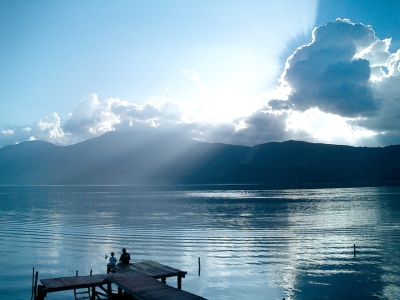
Lonely Planet’s doling out accolades to these ten countries as being very topping, with El Salvador being the toppingist of them all. Okay, they don’t really elaborate as to what this list mean, other than being the “hottest countries for next year,” but I assume they mean destinations that are, or have been, under the radar and are just coming into their own as hot spots for travelers. Which usually means one thing: Get there now before they’re firmly on the tourist trail.
Rounding out the top five are Germany, Greece, Malaysia and Morocco. And at number 10, experiencing a little Obama bounce, the U.S.A., which given the likelihood of a an anemic dollar for the near-term future, will likely be at the top of the list for many visitors, especially those carrying the enviably strong euro.
So what’s missing here? I may sound like a broken record, but let’s give a shout out to Colombia, a country whose culture and diversity, not to mention accessibility, makes it a great “top” country in 2010. A few of my own honorable mentions: Panama (have you seen how cheap it is to fly there in the winter?), Ireland (see Panama), and Namibia (everyone I met in Africa who was visited the country raved about the outdoor adventures that can be had there).
The post Lonely Planet’s Top 10 Countries For 2010: And The Winner Is . . . appeared first on The Expeditioner Travel Site.
]]>The post The Curious Case Of The Santorini Sunsets appeared first on The Expeditioner Travel Site.
]]>
Perhaps the world’s most beautiful, partially collapsed island in the world, Santorini is the only inhabited caldera in the world, and for some reason, known the world over for their immaculate sunsets. So popular are the sunsets that every twilight, hundreds of people gather to watch the sun dip below the horizon, a ritual that surely has gone back thousands of years.
Maybe it has to do with the water, or perhaps some sort of volcanic-related fumes emanating from the island, but my guess is that little things, like sunsets, just look better when lounging on a hilltop perch on a Greek island.
Santorini sunsets, viewed from the caldera, are said to be among the most beautiful in the world – a glorious explosion of color. The horizon glows, the cliff face lights up in a wash of pinks and purples, and the whole of the sea and sky seem to catch fire, melting into layers of crimson and liquid gold.
The post The Curious Case Of The Santorini Sunsets appeared first on The Expeditioner Travel Site.
]]>The post Food Shopping In Athens With 300,000 Of Your Closest Friends appeared first on The Expeditioner Travel Site.
]]>
Just around the corner from the Acropolis, Dimotiki Agora (or what English speakers refer to rather lamely as the Athens Central Market) is probably the best place to see modern Athens in all its chaotic glory.
Wandering around the seemingly endless corridors of vendors, if one was so willing or so motivated by their OCD, one could count “some 108 butchers, 150 seafood stands and 80 fruit and vegetable stalls” that cram themselves under a giant glass roof and hawk their goods to some 30,000 locals on a daily basis. (Multiply that number by ten come Christmas, Easter, and interestingly enough, President’s Day. Seems Lincoln is huge in Greece.)
There’s also a number of restaurants that can be found underneath where it’s recommended that you sit down and try a steaming bowl of patsas soup (a tantalizing mixture of bull or lamb stomach wall and lamb feet). And you were just going to pick up a gyro? How lame.
Here’s where you can find the market next time you’re in Athens.
The post Food Shopping In Athens With 300,000 Of Your Closest Friends appeared first on The Expeditioner Travel Site.
]]>The post Why You Should Skip Thanksgiving And Live It Up In Greece This Year appeared first on The Expeditioner Travel Site.
]]>
Forget Thanksgiving and live it up in Greece for the holidays where you can enjoy uncrowded sights, great weather, and food that will blow away a turkey dinner any day.
Want to take a Thanksgiving break that won’t break the budget? Head for Greece (just don’t order the fish…).
Greece’s thriving tourist trade is highly seasonal — three-quarters of visitors go between May and September — and there is a downside to visiting outside this period: you miss out on the main program of cultural events in the capital, plus the “party islands” virtually shut down. But there are compensations: accommodation and transportation can be dirt cheap, there’s an undeniable charm to exploring Athens’ atmospheric ancient sites without hoards of tourists to break the spell, and it’s not out of the question to find yourself turning a corner on an island coastal path and discovering a hidden beach that’s all your own.
Luckily, I’d saved enough days of holiday from work to be able to spend a whole week in the country, which I divided equally between Athens and the island of Tinos. But if you only have a long Thanksgiving weekend, the decision of whether to visit the famous city or the now equally renowned islands could be a tough one. Here’s how they compare . . .
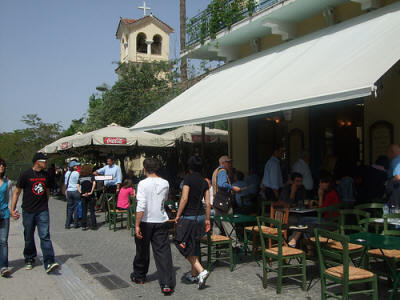 First things first: food. Greeks love eating with a passion and it shows. However, this may be lost on you in Athens if you fall into the trap of stopping at the modern restaurant-bars on Apostolou Parlou near the Acropolis. Don’t settle for an overpriced burger or club sandwich. Keep heading down to the bottom of the pedestrian strip, then turn right onto Adrianou on the south side of the Ancient Agora. Here there’s taverna after taverna staffed by waiters with as much local flavor and character as the dishes they serve. Meat dishes are varied and luxurious, including rooster, veal and lamb, and this is one place vegetarians won’t go hungry, with delicious stuffed peppers and vine leaves, zucchini pie, “giant beans” (one of my favorites) and of course the classic Greek salad.
First things first: food. Greeks love eating with a passion and it shows. However, this may be lost on you in Athens if you fall into the trap of stopping at the modern restaurant-bars on Apostolou Parlou near the Acropolis. Don’t settle for an overpriced burger or club sandwich. Keep heading down to the bottom of the pedestrian strip, then turn right onto Adrianou on the south side of the Ancient Agora. Here there’s taverna after taverna staffed by waiters with as much local flavor and character as the dishes they serve. Meat dishes are varied and luxurious, including rooster, veal and lamb, and this is one place vegetarians won’t go hungry, with delicious stuffed peppers and vine leaves, zucchini pie, “giant beans” (one of my favorites) and of course the classic Greek salad.
As you’d expect, island cuisine is all about seafood. The surprising part is the price. When a fellow tourist told me the going rate was around €70 per kilo, I assumed she’d got her figures wrong. But sure enough, a few hours later I was tucking into the most expensive (though sadly not the most impressive) fish I’ve ever tasted. Metaxy Mas, in the pretty Plateia Palladas alley to the west of the harbor, came recommended by locals. The staff didn’t speak much English, but when we asked about the fish we were led back to the kitchen where the chef proudly displayed the day’s choices. The red snapper we opted for was okay, but I was still left confused as to why it cost so much — particularly as, with no sign of fishing boats or even a fish market anywhere on the island, there was no evidence of it being any more fresh than anywhere else.
Much better value was the platter of “fisherman’s pasta” we ordered at Taverna Zeukz, on a side street off the main street. Portions were generous to say the least, and I’ve never come across such huge and flavorful mussels. It was just a shame we were the only people there to enjoy the feast.
Athens also has an obvious head start when it comes to sightseeing. The Acropolis is so iconic it’s easy to feel like you’ve already been there, but my first glimpse of the “sacred rock” was hardly a let down. It looks amazing lit up at night, especially when viewed from the Pnyx or one of the other nearby hills. And in daylight you can spend hours wandering around the majestic ruins for just €12, which includes admission to the city’s other major historical sites, including the Ancient and Roman Agoras, and the ancient graveyard, a pleasant place to spend a quiet hour or two watching the social interactions of the resident colony of tortoises.
“Old stuff” aside, I’d recommend visiting Syntagma Square. As parliament buildings go, Athens’ dull sand-colored block is something of a disappointment, but hang around to see the changing of the guard, which happens hourly, and you’re in for a spectacle. Let’s just say I never knew legs could go that high. Those boys should be ballerinas.
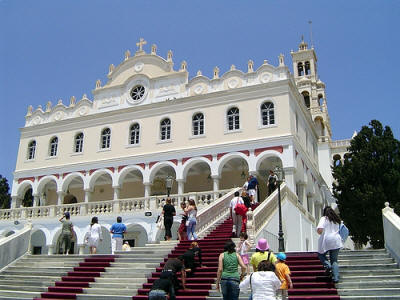 Tinos, located in the center of the Cyclades islands in the Aegean Sea and about halfway between Greece’s mainland and Turkey, is best known for the Church of Panagia Evangelistria, one of the most revered shrines in Greece. It draws a steady flow of pilgrims all year round, and many crawl on their hands and knees all the way up the long hill from the port to the church. In fact, the throng of people lining up to enter the shrine, all clutching bundles of candles several feet tall, left a greater impression on me than the marble building itself.
Tinos, located in the center of the Cyclades islands in the Aegean Sea and about halfway between Greece’s mainland and Turkey, is best known for the Church of Panagia Evangelistria, one of the most revered shrines in Greece. It draws a steady flow of pilgrims all year round, and many crawl on their hands and knees all the way up the long hill from the port to the church. In fact, the throng of people lining up to enter the shrine, all clutching bundles of candles several feet tall, left a greater impression on me than the marble building itself.
Other than the church, the best way to view the island is to hire a car, or — if you’re feeling daring — a motorbike from one of the many rental places in the town. It’s great fun winding around the coastal roads, or heading inland to explore the rugged hills, populated with old castles, churches, dovecoats, windmills and some of the prettiest villages in Greece. Volax, a small village on Tinos just a short distance from the port, is a tiny maze of attractive cottages built into the hillside and each other, while the village of Pirgos — which is almost entirely pedestrianized — is just the right size to allow yourself to be lost amongst the blue and white houses whose simple appeal is timeless.
Last but not least on my list of reasons to visit Greece: the people. Whether you opt for a city break or island retreat, it’s the friendliness and good humor of the locals that will really make your holiday — and visiting outside peak season means you’ll have even more opportunity to meet and get to know them. So what are you waiting for?

The post Why You Should Skip Thanksgiving And Live It Up In Greece This Year appeared first on The Expeditioner Travel Site.
]]>The post Skopelos: Ready For Its Closeup appeared first on The Expeditioner Travel Site.
]]>
Skopelos may be getting the Hollywood treatment, but this little Greek island isn’t letting it get to its head — with looks like this who needs Hollywood?
By Andy Boxall
As of the date of this publication, there are no official “Mamma Mia!” tours in Skopelos as there are “Sex in the City” tours in New York, but given Skopelos’ prominent role in the hugely successful film adaptation of the stage show, the idea doesn’t seem too far-fetched — in theory at least. In practical terms, it’s highly unlikely. This tiny island of 5,000, just to the east of Greece’s mainland, is about as eager to embrace its new-found famed as it is to embrace the modern world in general — which is to say: not at all. So you can breath a sigh of relief; you won’t find any ouzo Cosmopolitans here, but what you will find is a charming, beautiful Greek island with some of the best sights in the Aegean Sea, and with hardly a tourist in sight for most of the year. Or for that matter, a singing Pierce Brosnan, a godsend to all.
Just thirteen miles in length and five miles wide, Skopelos is perfect for anyone seeking seclusion. There’s no airport on the island, and the only way of getting there is via boat. If you’re combining your Greek visit with a few days in Athens — which is the recommended way of doing things — you can take a two-hour journey south to the port of Agios Konstantinos and board a catamaran that will take you to the inland in about two hours. (Or you can fly to nearby Skiathos and take an hour-long ferry from there instead, all depending on your tolerance for open-sea voyages.)
Outdoor Adventure
 In town you’ll see the familiar sights of white-washed houses, tiny, winding streets and plenty of tavernas (small restaurants serving Greek cuisine) and cafes, but it’s outside of town where Skopelos really comes alive. What may come as a surprise, especially if you have just come from smoggy Athens, is just how green and lush Skopelos is, perfect for both avid and casual hikers. With dense forests covering the mountain sides and fields of trees and wild flowers that dot the valleys, Skopelos is one of Greece’s greenest islands. And like many Greek islands, Skopelos is very mountainous, with two main peaks splitting the land, creating valleys and gorges across the landscape.
In town you’ll see the familiar sights of white-washed houses, tiny, winding streets and plenty of tavernas (small restaurants serving Greek cuisine) and cafes, but it’s outside of town where Skopelos really comes alive. What may come as a surprise, especially if you have just come from smoggy Athens, is just how green and lush Skopelos is, perfect for both avid and casual hikers. With dense forests covering the mountain sides and fields of trees and wild flowers that dot the valleys, Skopelos is one of Greece’s greenest islands. And like many Greek islands, Skopelos is very mountainous, with two main peaks splitting the land, creating valleys and gorges across the landscape.
One highly recommended trek is to scale Delphi, one of the many mountains on the island. Along the way you can expect to encounter many varieties of wildlife that call the island home, including various birds of prey, butterflies and all kinds of trees from plums to walnuts. The views from the mountain peaks overlooking the island to the sapphire-colored sea aren’t half-bad either.
 The southeastern part of the island is protected under the National Marine Park of the Northern Sporades and is home to several endangered species including the Mediterranean Monk Seal, one of the world’s most endangered mammals of which an estimated 500 remain in the world. The seals can also be found on the island of Alonnisos (the next island after Skopelos), the location of Europe’s largest Marine Park.
The southeastern part of the island is protected under the National Marine Park of the Northern Sporades and is home to several endangered species including the Mediterranean Monk Seal, one of the world’s most endangered mammals of which an estimated 500 remain in the world. The seals can also be found on the island of Alonnisos (the next island after Skopelos), the location of Europe’s largest Marine Park.
Hit The Beach
Life on Skopelos runs at a slightly slower pace, perhaps even slower than most other Greek islands, so don’t expect a bustling nightlife scene or couture-filled shopping centers when you’re back in town. No, this is a place for exploration, relaxation, and a return to a simpler way of living. While it may be a little busy during the high season, try to visit when things have settled down (May/June or September/October) and when the weather is still pleasant and the crowds have thinned considerably.
Like many Greek islands, Skopelos’ beaches are one of its main attractions. Kastani Beach (the location of many scenes of the movie) about 18 kilometers west of Skopelos Town is worth a visit for a swim in its clear waters, but a trip to Glysteri, just of north of town, is less well-known and therefore quieter but every bit as enjoyable.
Skopelos’ Newest Famous Locale
 Probably one of the most amazing sights in all of the island is the Agios Ioannis Chapel, the tiny chapel that sits precipitously atop a rocky outcrop above the choppy sea below. Located on the northern side of the island about an hour outside of Skopelos Town, this chapel was the location for the final wedding scene in the movie, contrary to rumors that this scene was actually shot in Corfu.
Probably one of the most amazing sights in all of the island is the Agios Ioannis Chapel, the tiny chapel that sits precipitously atop a rocky outcrop above the choppy sea below. Located on the northern side of the island about an hour outside of Skopelos Town, this chapel was the location for the final wedding scene in the movie, contrary to rumors that this scene was actually shot in Corfu.
They say that fame changes everything and if that were always true, Skopelos, after a starring role in a huge Hollywood production, should just about be in its falling-out-of-posh-parties-drunk-at-5-a.m.-phase right now. But the island has simply shrugged off its fifteen minutes like it never happened. Agriculture continues to be the main occupation and the seafront cafes retain the same clientele they did before any stars came to town. Just as the influx of tourists in summer is treated as something that just “happens,” so was the movie industry. Now it’s gone, Skopelos has quckly moved on, and has returned to what it always has been: a glorious, quiet, Mediterranean beauty spot.

The post Skopelos: Ready For Its Closeup appeared first on The Expeditioner Travel Site.
]]>The post No Boat Needed In Lefkada appeared first on The Expeditioner Travel Site.
]]>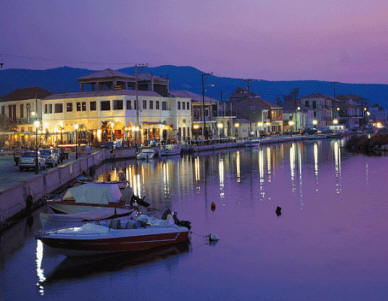
An Insider’s Look At The Greek Island Of Lefkada
By Andy Boxall
If you’ve never fulfilled your travel ambition of visiting a Greek island due to your reluctance to take to the open seas, located off the west coast, the Ionian island of Lefkada may be just what you’re looking for (click here for a map). Although the island is a six-hour drive from Athens, it’s possible to take a 45 minute flight from Athens International Airport and then hire a car, something considered essential once you’re there anyway. After crossing the short bridge that connects the mainland to Lefkada, you’re almost immediately amongst an abundance of trees, reenery and mountains.
Lefkada retains the traditional Greek island feel. The livelier towns of Nydri and Lefkas have plenty of afés, restaurants, shops and a smattering of nightlife; quieter villages like Vassiliki are less touristy and better for enjoying true Greek cuisine and mingling with the locals. Travel out of town however, and the island will begin to make sense; Lefkada isn’t about busy streets, it’s about beauty.
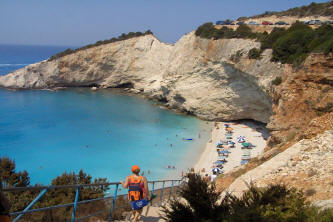
As you explore the twisting roads and climb higher into the mountains, the world seems to open up around you. Wonderful sea views stretch out, the famous island owned by the Onassis family, Scorpios, sits in the bay and olive groves and cotton fields pass you by as you drive. Heading west you’ll come upon Porto Katsiki, one of the most famous (and beautiful) beaches in the Mediterranean. Katsiki, with its towering white cliffs and sublimely clear water is a beachgoer’s paradise. The more adventurous can swim around an outcrop of rocks to find another, more secluded beach for themselves.
Accommodation on the island is mostly standard Greek island style apartments, but high on a mountain outside the tiny village of Vafkeri, those seeking a more luxurious, secluded stay will find Villa Nousia, a collection of private villas surrounded by stone patios and attractive gardens. Up here, incredible views can be enjoyed from your own private Jacuzzi before going for a dip in your swimming
pool.
Lefkada is the perfect choice for travelers who crave an authentic, Greek island
experience, without having to waste any precious hours on a ferry.

The post No Boat Needed In Lefkada appeared first on The Expeditioner Travel Site.
]]>